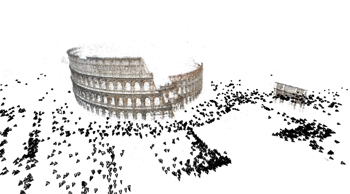Relevant Links
Press Release
Research Papers
Media Contact
Keywords
computer graphics, computer vision, computational photography, 3D reconstruction, Photosynth
Buzz
COMPUTING RESEARCH HIGHLIGHT OF THE WEEK [October 1 - 8, 2009]
Rome Was Built in a Day, with Hundreds of Thousands of Digital Photos
 Several years ago, a collaboration between computer graphics and computer vision researchers at the University of Washington and Microsoft yielded Photosynth (http://photosynth.net/), a revolution in organizing and navigating digital photographs.
Several years ago, a collaboration between computer graphics and computer vision researchers at the University of Washington and Microsoft yielded Photosynth (http://photosynth.net/), a revolution in organizing and navigating digital photographs.
Now, that same collaboration has yielded "Rome In A Day," which reconstructs entire cities from images harvested from the web, in less than a day of computation time per city.
Entering the search term "Rome" on Flickr.com returns more than two million photographs. This collection represents an increasingly complete photographic record of the city, capturing every popular site, facade, interior, fountain, sculpture, painting, cafe, and so forth. It also offers an unprecedented opportunity to richly capture, explore and study the three dimensional shape of the city.
In the "Rome In A Day" project, the UW and Microsoft researchers built a parallel distributed system that downloads all the images associated with a city - say Rome - from Flickr.com. It matches these images to find common points and uses this information to compute the three dimensional structure of the city and the pose of the cameras that captured these images. All in less than a day.
This poses new challenges for every stage of the 3D reconstruction pipeline, from image matching to large scale optimization. The key contributions of the work are a new, parallel distributed matching system that can match massive collections of images very quickly, and a new bundle adjust software that can solve extremely large non-linear least squares problems that are encountered in three dimensional reconstruction problems.
The technique could create online maps that offer viewers a virtual-reality experience. The software could build cities for video games automatically, instead of doing so by hand. It also might be used in architecture for digital preservation of cities, or integrated with online maps.
Researchers:
Sameer Agarwal, University of Washington [http://www.cs.washington.edu/homes/sagarwal/]
Noah Snavely, Cornell University [http://www.cs.cornell.edu/~snavely/]
Ian Simon, University of Washington [http://www.cs.washington.edu/homes/iansimon/]
Steve Seitz, University of Washington [http://www.cs.washington.edu/homes/seitz/]
Richard Szeliski, Microsoft Research [http://research.microsoft.com/en-us/um/people/szeliski/]
Research support provided by:
The National Science Foundation, the Office of Naval Research and its Spawar lab, Microsoft Research, and Google
‹ Current Highlight | Past Highlights ›
Computing Research Highlight of the Week is a service of the Computing Community Consortium and the Computing Research Association designed to highlight some of the exciting and important recent research results in the computing fields. Each week a new highlight is chosen by CRA and CCC staff and volunteers from submissions from the computing community. Want your research featured? Submit it!.




